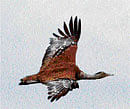
During the last status update, Birdlife International found only 296 bustards scattered in isolated pockets of Gujarat, Madhya Pradesh, Rajasthan, Maharashtra, Andhra Pradesh and Karnataka. The revelation forced IUCN to elevate the status of the bird from endangered to critically endangered, writes Atula Gupta
The Great Indian Bustard is the third biggest flying bird in the world, but the quest to find it in the great vastness of India is ironically, the biggest challenge naturalists face nowadays. As its grassland home is mercilessly divided into bits and pieces of fragmented land, less than 300 of the species remain in India compared to more than thousands not very long ago. And a recent study points out that habitat destruction is just one of the many hurdles standing in the way of this critically endangered bird.
The majestic Indian member of the bustard family was not always living in such dire conditions. Till the 19th century, there were many occasions when at least 20 to 30 individuals were sighted peacefully roaming open scrubs and grassy pastures of the Indian subcontinent. From Uttar Pradesh to Tamil Nadu, Sindh in Pakistan to Orissa, they navigated almost the entire country. But sadly the surplus disposal of four wheel drives after the Second World War, the Partition and then the urgent development needs of the newly formed countries and the improved weapons in the hands of unscrupulous hunters started the demise of the Great Indian Bustard.
During the last status update, Birdlife International found only 296 individuals scattered precariously in a few isolated pockets of Gujarat, Madhya Pradesh, Rajasthan, Maharashtra, Andhra Pradesh and Karnataka. The revelation forced International Union for Conservation of Nature (IUCN) to elevate the status of the bird from endangered to critically endangered, one step closer to getting extinct.
Disappearing act
The Indian Bustard is a majestic specimen of its kind - tall, regal and with males having a distinct booming call that have given them the name of hoom or hookna. Noted ornithologist Salim Ali was so fascinated by the species that he suggested the Indian Bustard be made the national bird of the country. Sadly, with the title going to the pea-fowl, the bustard lost prominence and wary of human presence, it remained hidden in the meadows. But gradually scrubs became farmlands, mud paths became highways and the bustards were trampled, neglected and left with no home in sight.
The tragic Houdini act of the Great Indian Bustard would have continued if not for the alarm bells that rung worldwide after the last population census. In 2011 the government finally took the bird under its wings under the Species Recovery Programme, run especially for Indian wildlife in need of urgent protection and conservation.
Nature has equipped these portly navigators of grasslands with tools well adapted to the environs they live in. These birds are opportunist eaters, and their diet ranges widely depending on the seasonal availability of food - grass seeds, insects, and sometimes even small rodents and reptiles. But what nature missed was to equip them with abilities to fight man-made alterations. Despite being built to survive in harsh weather conditions, they have been exterminated from almost 90 per cent of their former range.
Man- made troubles
Experts preparing a guideline for the Environment ministry found that one of the major threats to these isolated groups of birds was poor genetic diversity which ultimately could lead to weakening the future generations. There was also the threat of collision with high tension electricity wires. Sutirtha Dutta, a doctoral researcher at the Wildlife Institute of India said that over the years the landscape has changed drastically.
In some places such as Rajasthan where the bustard is the state bird, increased irrigation by the Indira Gandhi canal have led to increased agriculture and altered habitat, making it difficult for the bustard to find food or even find a safe shelter. Adding to their woes are domestic and stray animals. “I have seen the bustards being chased off by domestic dogs, who have reached the interiors of grasslands with recent settling of farmers in Kutch,” Dutta said.
A number of protected areas have been set up across bustard distribution range like Naliya in Gujarat, Rollapadu in Andhra Pradesh and Desert National Park in Rajasthan. But within these areas are privately owned lands where the forest department does not have a hold. The bustards therefore are not safe even within the protected fences.
Its seasonal movement pattern and areas where the bird loves to inhabit within India have not been studied. There is no evidence whether it is affected by the use of pesticides on food crops. Further, unethical photography during the breeding season often acts as a constant source of disturbance for the shy birds.
Fighting chance
The government proposes to run a Project Bustard on the same lines as the Project Tiger very soon.
In-situ breeding programmes, appointment of more forest guards to protect breeding pairs and revamping grassland protection policies are some of the ideas waiting to be executed. There are also plans to acquire more land that act as buffer zones outside the protected parks. But the knowledge that grasslands form an important part of the ecosystem has to be widespread. Before running the bulldozers, a thought has to be spared for the magnificent Indian bird that is part of the world beyond soot and suffocation.